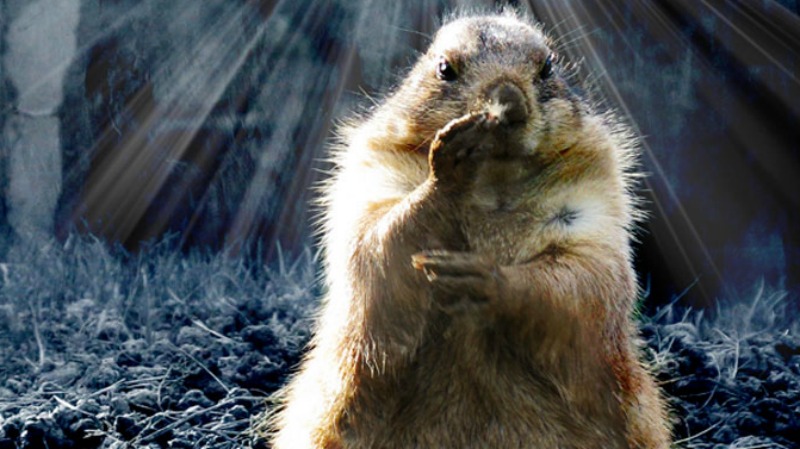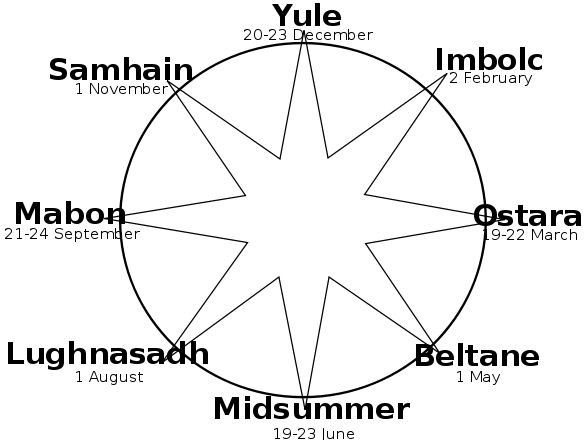
Image via kidskonnect
Ah, Groundhog Day. On this Groundhog Day – February 2, 2018 – will Punxsutawney Phil – called the world’s most beloved seasonal prognosticator by his handlers in Punxsutawney, Pennsylvania – see his shadow? If not, it means spring will come early this year … at least, according to folklore.
Groundhog Day, a U.S. and Canadian tradition, comes every year on February 2. It has its roots in astronomy, in the sense that it’s a seasonal festival, tied to the movement of Earth around the sun. It’s a great excuse to go outside and enjoy some revelry during the winter months. Follow the links below to learn more.
Punxsutawney Phil, the great weather prognosticator.
Groundhog Day has its roots in astronomy.
Groundhog Day in various cultures.
… the great weather prognosticator. See Phil on the far left? Image via Wikimedia Commons.
Punxsutawney Phil, the great weather prognosticator. We all know the rules of Groundhog Day. On February 2, a groundhog is said to forecast weather by looking for his shadow. If it’s sunny out, and he sees it, we’re in for six more weeks of winter. On the other hand, a cloudy Groundhog Day is supposed to forecast an early spring.
Of course, it can’t be cloudy, or sunny, everywhere at once. And many towns in the U.S. and Canada have their own local groundhogs and local traditions for Groundhog Day.
But by far the most famous of the February 2 shadow-seeking groundhogs is Punxsutawney Phil in Punxsutawney, in western Pennsylvania, which calls itself:
… original home of the great weather prognosticator, His Majesty, the Punxsutawney Groundhog.
Since 1887, members of the Punxsutawney Groundhog Club have held public celebrations of Groundhog Day. Punxsutawney is where Bill Murray was in the movie Groundhog Day. From the looks of things … a good time is had by all.
How accurate is Phil? NOAA’s National Climatic Data Center says Phil’s forecasts have shown no predictive skill in recent years.
AccuWeather, on the the hand, says the groundhog is a better-than-average predictor, with an 80 percent accuracy rate.
The equinox is an event that takes place in Earth’s orbit around the sun.
Groundhog Day has its roots in astronomy. What you might not know is that Groundhog Day is really an astronomical holiday.
It’s an event that takes place in Earth’s orbit around the sun, as we move between the solstices and equinoxes. In other words, Groundhog Day falls more or less midway between the December solstice and the March equinox. Each cross-quarter day is actually a collection of dates, and various traditions celebrate various holidays at this time. February 2 is the year’s first cross-quarter day.
Of course, the division of the year into segments is common to many cultures. Our ancestors were more aware of the sun’s movements across the sky than we are, since their plantings and harvests depended on it.

Neo-pagan wheel of the year. Image via Wikimedia Commons.
Groundhog Day in various cultures. In the ancient Celtic calendar, the year is also divided into quarter days (equinoxes and solstices) and cross-quarter days on a great neopagan wheel of the year. Thus, just as February 2 is marked by the celebration of Candlemas by some Christians, such as the Roman Catholics, in contemporary paganism, this day is called Imbolc and is considered a traditional time for initiations.
The celebration of Groundhog Day came to America along with immigrants from Great Britain and Germany. The tradition can be traced to early Christians in Europe, when a hedgehog was said to look for his shadow on Candlemas Day.
Try this old English rhyme:
If Candlemas Day be fair and bright, winter will have another flight. But if it be dark with clouds and rain, winter is gone and will not come again.
Or here’s another old saying:
Half your wood and half your hay, you should have on Candlemas Day.
In Germany it used to be said:
A shepherd would rather see a wolf enter his stable on Candlemas Day than see the sun shine.
There, a badger was said to watch for his shadow.
A friend on Facebook said that, in Portugal, people have a poem about February 2 related to the Lady of Candles. Here’s the poem:
Quando a Senhora das Candeias está a rir está o inverno para vir, quando está a chorar está o inverno a acabar. [Translation: If she smiles (Sun) the winter is yet to come, if she cries (Rain) the winter is over]
Cloudy, one of the groundhogs at Brookfield Zoo in Brookfield, Illinois. contemplates an exit from her wooden home on Groundhog Day. Photo via Tim Boyle/Newsmakers.
One final note. It’s supposed to be bad luck to leave your Christmas decorations up after Groundhog Day.
The National Geographic Society once studied the groundhog and found him right only one out of every three times. But what the heck? It’s all in good fun.
So whether you celebrate with a real groundhog and a real shadow – or just pause a moment on this day to reflect on the passing of the seasons.
Enjoying EarthSky so far? Sign up for our free daily newsletter today!
Bottom line: Groundhog Day comes every year on February 2. It has its roots in astronomy, in the sense that it’s a seasonal festival,
from EarthSky http://ift.tt/1o1Yu0E

Image via kidskonnect
Ah, Groundhog Day. On this Groundhog Day – February 2, 2018 – will Punxsutawney Phil – called the world’s most beloved seasonal prognosticator by his handlers in Punxsutawney, Pennsylvania – see his shadow? If not, it means spring will come early this year … at least, according to folklore.
Groundhog Day, a U.S. and Canadian tradition, comes every year on February 2. It has its roots in astronomy, in the sense that it’s a seasonal festival, tied to the movement of Earth around the sun. It’s a great excuse to go outside and enjoy some revelry during the winter months. Follow the links below to learn more.
Punxsutawney Phil, the great weather prognosticator.
Groundhog Day has its roots in astronomy.
Groundhog Day in various cultures.
… the great weather prognosticator. See Phil on the far left? Image via Wikimedia Commons.
Punxsutawney Phil, the great weather prognosticator. We all know the rules of Groundhog Day. On February 2, a groundhog is said to forecast weather by looking for his shadow. If it’s sunny out, and he sees it, we’re in for six more weeks of winter. On the other hand, a cloudy Groundhog Day is supposed to forecast an early spring.
Of course, it can’t be cloudy, or sunny, everywhere at once. And many towns in the U.S. and Canada have their own local groundhogs and local traditions for Groundhog Day.
But by far the most famous of the February 2 shadow-seeking groundhogs is Punxsutawney Phil in Punxsutawney, in western Pennsylvania, which calls itself:
… original home of the great weather prognosticator, His Majesty, the Punxsutawney Groundhog.
Since 1887, members of the Punxsutawney Groundhog Club have held public celebrations of Groundhog Day. Punxsutawney is where Bill Murray was in the movie Groundhog Day. From the looks of things … a good time is had by all.
How accurate is Phil? NOAA’s National Climatic Data Center says Phil’s forecasts have shown no predictive skill in recent years.
AccuWeather, on the the hand, says the groundhog is a better-than-average predictor, with an 80 percent accuracy rate.
The equinox is an event that takes place in Earth’s orbit around the sun.
Groundhog Day has its roots in astronomy. What you might not know is that Groundhog Day is really an astronomical holiday.
It’s an event that takes place in Earth’s orbit around the sun, as we move between the solstices and equinoxes. In other words, Groundhog Day falls more or less midway between the December solstice and the March equinox. Each cross-quarter day is actually a collection of dates, and various traditions celebrate various holidays at this time. February 2 is the year’s first cross-quarter day.
Of course, the division of the year into segments is common to many cultures. Our ancestors were more aware of the sun’s movements across the sky than we are, since their plantings and harvests depended on it.

Neo-pagan wheel of the year. Image via Wikimedia Commons.
Groundhog Day in various cultures. In the ancient Celtic calendar, the year is also divided into quarter days (equinoxes and solstices) and cross-quarter days on a great neopagan wheel of the year. Thus, just as February 2 is marked by the celebration of Candlemas by some Christians, such as the Roman Catholics, in contemporary paganism, this day is called Imbolc and is considered a traditional time for initiations.
The celebration of Groundhog Day came to America along with immigrants from Great Britain and Germany. The tradition can be traced to early Christians in Europe, when a hedgehog was said to look for his shadow on Candlemas Day.
Try this old English rhyme:
If Candlemas Day be fair and bright, winter will have another flight. But if it be dark with clouds and rain, winter is gone and will not come again.
Or here’s another old saying:
Half your wood and half your hay, you should have on Candlemas Day.
In Germany it used to be said:
A shepherd would rather see a wolf enter his stable on Candlemas Day than see the sun shine.
There, a badger was said to watch for his shadow.
A friend on Facebook said that, in Portugal, people have a poem about February 2 related to the Lady of Candles. Here’s the poem:
Quando a Senhora das Candeias está a rir está o inverno para vir, quando está a chorar está o inverno a acabar. [Translation: If she smiles (Sun) the winter is yet to come, if she cries (Rain) the winter is over]
Cloudy, one of the groundhogs at Brookfield Zoo in Brookfield, Illinois. contemplates an exit from her wooden home on Groundhog Day. Photo via Tim Boyle/Newsmakers.
One final note. It’s supposed to be bad luck to leave your Christmas decorations up after Groundhog Day.
The National Geographic Society once studied the groundhog and found him right only one out of every three times. But what the heck? It’s all in good fun.
So whether you celebrate with a real groundhog and a real shadow – or just pause a moment on this day to reflect on the passing of the seasons.
Enjoying EarthSky so far? Sign up for our free daily newsletter today!
Bottom line: Groundhog Day comes every year on February 2. It has its roots in astronomy, in the sense that it’s a seasonal festival,
from EarthSky http://ift.tt/1o1Yu0E

Aucun commentaire:
Enregistrer un commentaire